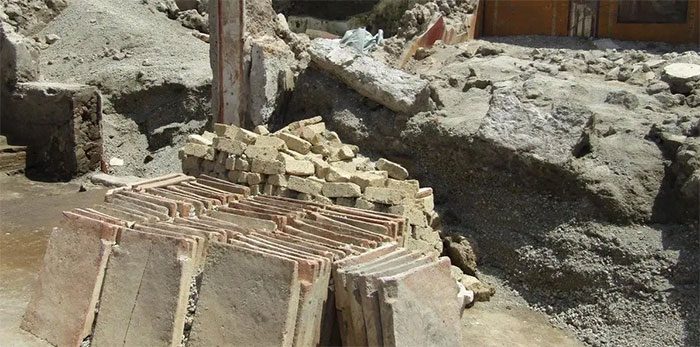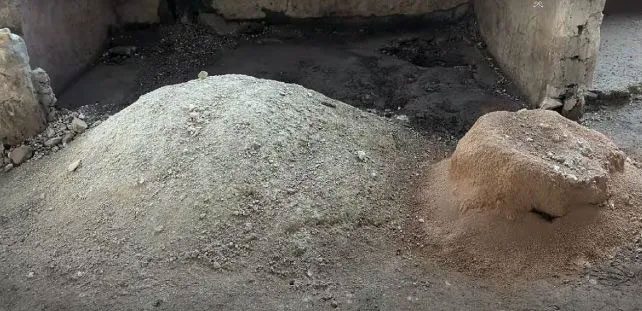New Excavation at the “City of Stone” Pompeii Reveals an Unimaginable Treasure for Archaeologists.
According to Science Alert, what the excavation team at the Pompeii Archaeological Park (Italy) refers to as the “most unusual treasure” is a vast house where everything inside appears to be frozen in time for 2,000 years.

An ancient construction site with neatly arranged stone slabs – (Photo: POMPEII ARCHAEOLOGICAL PARK).
Pompeii is an ancient city that was devastated by the eruption of Mount Vesuvius in 79 AD.
This site is famous for its “fossilized people” in various postures, representing victims who were enveloped by volcanic ash so quickly that they died while maintaining the positions they held in life: lying down, sitting with knees drawn up, running…
The sudden collapse of lava and ash also helped preserve much of the intact infrastructure, but nothing has been as extraordinary as what has just been discovered.

Even the piles of lime are still intact – (Photo: POMPEII ARCHAEOLOGICAL PARK).
According to Science Alert, they have stumbled upon a construction site preserved in a state as if it were still active, despite being 2,000 years old.
Inside the house, where repair work was taking place just before the disaster struck, are piles of lime that show no sign of decay, neatly arranged floor tiles ready for installation…
All of this provides archaeologists with a perfect time slice, allowing them to see directly into human activity and construction techniques from 2,000 years ago.
The house belonged to a baker, and it still contains an intact oven inside.
Scientists also found a piece of art depicting flatbread and a glass of wine, as well as a campaign poster showing support for a politician named Aulus Rustius Verus.
Not far from the oven, the remains of two women and a boy were also discovered.
In the reception area of the house, artifacts used for counting related to construction are still intact.
Meanwhile, in the family’s shrine, there are amphorae used to mix plaster to finish the walls in the room.
Some construction tools still in use today, such as plumb bobs and concrete mixing tools, were also found in other rooms.
This discovery is particularly significant as it reveals the formulas and methods for mixing concrete used by the ancient Romans, known for its durability and even the ability to self-repair small cracks, allowing it to last for thousands of years.
Analysis shows that dry lime and dry pozzolana are mixed with very hot water to create a highly durable concrete, which sets quickly and self-repairs due to moisture.
Pozzolana is an inorganic material that can combine with lime to form a compound with adhesive properties similar to cement. Natural pozzolana is usually volcanic ash or pumice. Artificial pozzolana can be produced from certain industrial waste materials.
The skills of the people of Pompeii and the ancient Romans are impressive enough that scientists believe modern humanity can learn a great deal from their construction techniques and material technologies.


















































